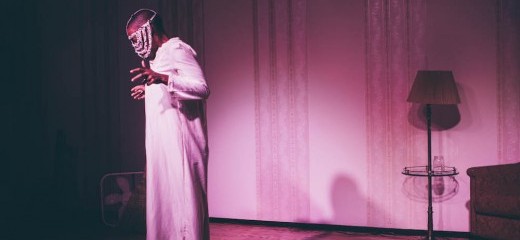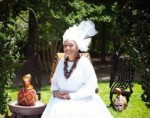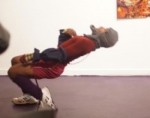
diving into ocean, we grow our wings
by L. Graciella Maiolatesi
water trickles down flesh
ocean kisses in the living room
generations of sweat line our tongues
how do we honor our peoples
sips libation, watering altars within
the Zoom screen is filled with ocean waves that rock me; the sound of their soft crashing drifts through my speakers and immediately i am home, holding hands with a black matriarch whose face i do not know but whose hands i recognize. text appears on screen, in front of the waves:
“Fly/Drown is for Black women. it is a love letter to Black women— a love so deep we work through undecorated truths with one another in order to relearn and reclaim the flight in our flesh. this work is about breath. it is about demanding a breath pattern that prioritizes the exhale. it is a roadmap towards flight, which is also a return to water.”
Fly/Drown, a dance film produced by Detroit artists Devin Drake and Jennifer Harge, choreographed and performed by Jennifer Harge, is being presented through The Philadelphia Thing’s Trade School, in collaboration with the Detroit-based A Host of People. the signature program of The Philadelphia Thing, Trade School serves as an artistic exchange platform that celebrates the work of Philadelphia performing artists, and creates connections with other artists across the country.
Zoom screen becomes portal, fading from colorful ocean waves to the inside of a house. shot in black and white, the camera pans around the home and we see snippets of the lives it has held: old photographs line the walls, stuffed armchairs that ask you to stay a while, intergenerational laughter, and an empty bottle of Henny. the light on the screen flickers and there is a Black figure dressed in white, perched on rocks near the water’s edge. the figure wears a white mask made of decorative gemstones and shells glued to strips of cloth that then attach to one central line of fabric; a water spirit’s ribcage come to protect her lineage. the figure shifts on the rocks, rotating their weight through small, subtle undulations living in their spine and shoulders, scapula gossiping lovingly with tailbone—
here, i pause to insert that while the piece is dedicated to “Black women,” this Black figure dressed in white transcends the gender binary for me, a queer-Black-fat-femme-creative: not necessarily erasing it entirely, just carving out space for more. the figure feels both ancestral and from the future, existing in multiple planes, appearing in this plane in the form of what we have been socialized to understand as a “Black woman,” allowing us to both witness and worship her. but because the figure reads as spirit, i experience them more as a Black femme energy in motion, and when discussing femme energy in relation to Blackness, i always mean an energy that is radically soft. for all of these truths, i will use they/she pronouns to refer to the Black figure in white throughout the remainder of this article. this is further supported by the fact that Jennifer Harge also identifies with they/she pronouns.
—returning us to the living room, the masked, black figure in the long white dress is lying on the couch in the dark, asleep. next frame shows her looking longingly out the window, glittering moonlight reflected from their mask. suddenly a light turns on and the figure is moving about the living room, carving through space with their hips, gently scooping inwards with her arms. the film overlaps here with two recordings layered over one another, introducing a textured existence to the work that visually allows the figure to exist in multiple planes at once. the figure is both moving in front of a tv and hugging that tv at the same time. the shot cuts to the figure taking a slow sip of water from a metal cup as photographs of generations of Black women silently watch her from their hanging wall frames; the black and whiteness of their photos creates just enough of a time warp that i can smell the heat of the hot comb that has made their hair so straight. the Black figure in white nods her head as she sips on the water and the film flickers—maybe the figure glitches—and we are now in a different part of the living room.
the Black figure is lying against an armchair, the skirt of their white dress pooling around them. effort is in the air, and as the skirt of the dress moves, we see the figure is not fully sitting on the ground; back against the chair, the figure is digging their heels into the floor and pressing all their weight into the chair’s cushions. panting, they reach behind them with their right arm, hand grasping for another hand that isn’t there to pull them up. groaning turns into guttural rasps and as they use their back to push themselves, climbing the upholstery of the chair, they begin to slowly open and close their legs, rocking pelvis back and forth.
what does it mean to birth new worlds?
camera pans out to reveal a grouping of empty glass jars behind the figure, and as the camera angle continues shifting, we see that the figure is surrounded by a live audience. has the audience been there the entire time? the audience witnesses the Black figure in white, but the figure is still in her own world, lost in conversation with the universe as she undulates her torso violently, flapping her arms, releasing a scream centuries old. the figure grabs a broom and holds it upside down; bristles facing the ceiling, she begins to sway, stirring the air. shaping time. the figure begins to swing the broom pedestrianly as if swatting at a roach scurrying across the wall, and the spell is broken. the beating becomes defeated, the roach victorious, and the figure drops the broom, cueing a recording of a low, sultry note sung by Aretha Franklin. the figure is still looking at the ceiling as the music begins to build, the gospel figuratively pulling at the seams of the figure’s very core until the figure herself is split in two. here is another moment in which separate, choreographed movements have been superimposed, with one of the frames edited to be slightly opaquer than the other. this dual existence in the same cinematic shot again suggests that the Black figure in white is more spirit embodied than the body of a Black woman accessing spirit, and that the two planes we witness them in are just two of the infinite planes the spirit occupies.
in one plane the Black figure begins to carve through space with their arms, cutting the air with their shoulders, elbows, and fingertips. In another plane, the figure is clad in white bra and briefs, praying as she airs out her white dress. both figures seem to be seeking something. the figure circling their arms lowers them, and steps into a metal basin full of water. the superimposed planes overlap, a blending of technology, until only one Black figure in a white dress remains. stepping out of the metal basin, the figure reveals a soaking wet, weighted ankle bracelet that they remove before shuffling towards a porcelain bathtub. naked and submerged, face barely above the surface of the porcelain tub, the figure treads the line between sinking and floating.
what oceans must we drown in before we sprout wings?
the Black figure sits up in the tub and is physically joined by the embodiment of the Black matriarch from before whose face i did not know but hands i recognized. the matriarch assists in attaching a wire crown to the Black figure’s glittery mask. the figure puts their white garment back on; air drying, they pick up their broom and continue sweeping, disappearing into audience, morphing back to ocean.
flesh dissolves in ocean
laughter fills living room wakes
generations of climax
tears drown inner elbows
how do we honor our peoples
diving into ocean, we grow our wings
Fly/Drown, Directed by Devin Drake and Jennifer Harge, Trade School 2020, Jan. 21.
By L. Graciella Maiolatesi
February 7, 2021







